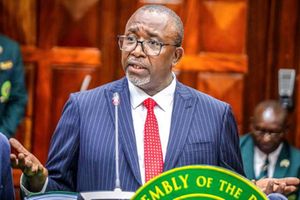Government plans to borrow Sh100 billion to pay old debts

National Treasury Cabinet Secretary Henry Rotich at Parliament Buildings during budget presentation for the fiscal year 2018/19 on June 14, 2018. PHOTO | FILE | NATION MEDIA GROUP
What you need to know:
- The quick loans may have become Treasury’s resort to fund its expenditures including loan repayments.
- The loan will be the sixth syndicated one arranged by the Trade and Development Bank, according to disclosures made in a Eurobond prospectus earlier this year.
The story of Kenya’s borrowing spree since 2013 has been a potpourri of secretive deals, lopsided contracts and massive loans whose use raises more questions than answers.
Revelations that the government plans to borrow Sh100 billion to settle two other syndicated loans maturing next year have once again turned the spotlight on the rising level of debt.
On Saturdayy, National Treasury Cabinet Secretary Henry Rotich came out to explain the decision amid public outcry, saying the latest move — said to be arranged by the Trade and Development Bank (formerly PTA Bank) — will only help to lengthen the maturities of the Eurobond debts beyond the 2019 date.
“We are doing a syndicate to term out (lengthen maturity) of a maturing two-year syndicated loan taken in April 2017. This is a standard practice worldwide to retire short-dated loan and replace it with longer-dated loan as part of liability management,” Mr Rotich told the Nation.
SYNDICATED LOAN
The Cabinet Secretary denied reports that Kenya was opting for a more expensive syndicated loan option to settle the Eurobonds taken in 2014. Such a move could pile more repayment pressure on the loans since it is almost impossible to secure a syndicated loan at a rate equal to or lower than the 5.75 per cent Eurobond was secured at.
Critics of the syndicated loan approach, however, believe the country may be running out of options to go back to the international market. This is after conditions worsened with lenders now demanding more returns coupled with the public scrutiny that followed the floating of the first and second Eurobonds.
Under the syndicate loan arrangement, a bank (syndicate) is used to source for the borrowed billions from various lenders, including other financial institutions and individuals, who remain unknown, at usually higher interest rates compared to the open debt market.
FLOAT ANOTHER BOND
With no need of a prospectus to explain the finer details of the loan to the public, the quick loans may have become Treasury’s resort to fund its expenditures including loan repayments.
Economist David Ndii described the move as a fallback strategy for Kenya, which is now less optimistic to go back to the international market to float another bond.
“We are in a financial distress and Kenya knows that should we go to the international market now we will obviously get pricing even above 10 per cent.
“A syndicate is like a shylock unlike going to a corporate bond where you can be advised on better options. It will be important to know whether this is in addition to the corporate bonds or an alternative,” Mr Ndii said.
The loan will be the sixth syndicated one arranged by the Trade and Development Bank, according to disclosures made in a Eurobond prospectus earlier this year.
In February, Kenya raised its second Eurobond in a span of four years. The Sh202 billion ($2 billion) bond that has a 30-year maturity period will cost taxpayers at least Sh323 billion in interest repayments as various international agencies continue to raise concerns over Kenya ‘s fiscal deficits that push it to keep borrowing.
BALLOONING BURDEN
The taxpayers will also have to pay the lenders the principal of $2 billion at the dates of maturity in February 2028 and 2048. The first such bond raised $2.75 billion issued in 2014 in two tranches of five ($750 million) and 10-years ($2 billion).
Since 2013, the level of debt has been on a steep climb amid concerns the economy could fail to cope with the ballooning burden. President Uhuru Kenyatta’s government has put more preference on commercial and semi-concessional loans instead of the cheaper concessional loans that have more flexible repayment terms.
The Chinese government has particularly been the focus of attention over the dishing of loans with the Standard Gauge Railway project being the most prominent.
In a recent special report, the Nation detailed how the Treasury has come under increasing pressure to show value for the multi-trillion-shilling loans Kenya has accumulated in recent years as taxpayers stare at record high debt repayments.
Maturity of some of the commercial and semi-concessional loans the country has contracted from foreign and domestic investors has pushed debt obligations to a new high.
NATIONAL WEALTH
In October, former Chief Justice Willy Mutunga renewed calls for an independent public inquiry into how the Sh5.04 trillion debt has been accumulated and the value it has had on the economy in terms of growing national wealth — gross domestic product.
“We need a commission of inquiry into public debt since independence,” Dr Mutunga said during the launch of taxpayers’ month graced by Mr Rotich. “The questions may never go away if we don’t address this.”
Mr Rotich dismissed claims of Kenya’s debt burden being too heavy.
“We present a budget to parliament, we fully indicate the existing deficit, which is meant to be plugged by borrowing and the MPs approve it as it is. You should be surprised when you hear them (MPs) criticise it. I don’t mean to say we don’t really worry about the strain debt repayment will have on the economy but I can assure you it is well thought-out,” Mr Rotich told the Nation on Saturday.
BORROWING CEILING
In 2014, Parliament increased external borrowing ceiling from Sh1.3 trillion to Sh2.5 trillion, but in 2015 the Public Finance Management Act was amended and parliamentary oversight role was removed giving leeway for increased borrowing which now stands at more than Sh5 trillion.
Kenya is set to spend a record Sh1 trillion — equivalent to Sh54 out of every Sh100 collected in revenue — servicing debt in the 2018/2019 fiscal year, up from Sh658.2 billion in the current fiscal year and Sh435.7 billion in 2016/17. The amounts cover both principal maturities and interest payments.
There have also been concerns that some ministries and government departments have been on a borrowing spree by engaging international financiers in big projects, some of which do not give value for money.
An example of such “contractor-negotiated foreign loans” is the Sh30 billion the Ministry of Energy signed with an Israeli security services provider to secure the crude pipeline from Turkana to Lamu, which is yet to be properly conceptualised (see story on Page 5).
LOPSIDED CONTRACTS
The international firms would usually approach a government department with a convincing proposal complete with funding arrangements and later have the Treasury approve the loans that are sometimes accompanied by lopsided contracts and costly repayment terms.
However, Mr Rotich told the Nation the recent guidelines issued on such arrangements will tame the project conceptualisations that have been rampant over the years.
Treasury formally imposed tighter controls on planned government programmes, pushing through yet another critical piece of action needed to reduce spending and restore stability in the country's public finances.
BUDGET PRIORITIES
In a circular sent to ministries, departments and agencies, the Treasury says any new proposals submitted through sector working groups (SWGs) that decide on budget priorities must focus on President Kenyatta's “Big Four” agenda and completion of ongoing projects.
“The government recently directed that no new projects should be started without the approval of the National Treasury.
“The SWGs are therefore advised to only consider new projects approved by the National Treasury [with] … priority to “Big Four” interventions and completion of ongoing projects,” Treasury Secretary Henry Rotich says in the circular intended to ensure greater spending control.





